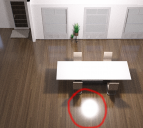Light source reflection
 roezaka
Posts: 64
roezaka
Posts: 64
Is it possible to somehow remove this reflection of the light source?
There is a point light above the table. I replaced it with emissive light of a similar shape, and set the opacity to 0.0001, but that doesn't help.
It only helps if you set the emission light to the entire ceiling, but then the shadows disappear. There is a solution?


ывпавпрап.png
1000 x 893 - 2M


Comments
iray simulates the real interaction between light, surfaces and volumes, so the answer is no
in thìs case you can lower the floor glossines or change to camera position.
in any case you need to consider the reality and think like a photographer
The short answer is yes.
It appeared that the point light above the table generated a hotspot aimed at the floor. That usually happened when the light is too intense and focused. Imagine shining a high power flash light on a object with a narrow focus beam.
To resolve this, you can either point the beam somewhere else or 'unfocus' the beam.
When you replaced the 'Point light of similar shape, did you meant a sphere? A point light is a point and it has no geometry (although you can argue it's a very tiny sphere).
When you made your ceiling emissive, it helped, but the shadows disappear. This is logical, but to understand you must know how light behaves with different type of lighting.
In this pic, I used a point light positioned above the table. The luminanous flux is set at 500000 lm You can see the hotspot on the table. The shadow is very promininent
In this image I turned off the point light and only used a mesh light ( a Primitive plane .25 x .25 meter). I've placed it at the same spot as the point light. the Luminous flux is also set at 500,000 lm. As you can see, the hotspot and the overall lighting is dimmer. The shadow is softer.
In this image, I turned off the point and mesh light and only used the emissive ceiling. As you can see the hotspot is completely gone, the lights is even dimmer and the shadow is barely noticeable.
Just for good measure, I throw in this image. As you can see, all three light sources are turned on. You can see the combination of the effect.
In conclusion.
Light geometry partially determine your coverage and shadows. The smaller the surface area of you light, the more intense the focus and the deeper the shadows. As the area grow (from point to mesh to ceiling (even larger mesh) the focus becomes less intense, and the shadows less harsh..
To answer your last question : Yes, and this is the long version.
Finally, there are other type of lights to explore.
My favorite light is the spot light. It's like the Swiss Army Knife of lights. The point and mesh light is built into the spot light. The spot light has the most control of any of the light types combined in Daz Studio.